Java Annotation是JDK5.0引入的一種注釋機制。
網上很多關於Java Annotation的文章,看得人眼花缭亂。Java Annotation本來很簡單的,結果說的人沒說清楚;弄的看的人更加迷糊。
我按照自己的思路,對Annotation進行了整理。理解 Annotation 的關鍵,是理解Annotation的語法和用法,對這些內容,我都進行了詳細說明;理解Annotation的語法和用法之後,再看Annotation的框架圖,可能有更深刻體會。廢話就說這麼多,下面開始對Annotation進行說明。若您發現文章中存在錯誤或不足的地方,希望您能指出!
第1部分 Annotation架構
先看看Annotation的架構圖:
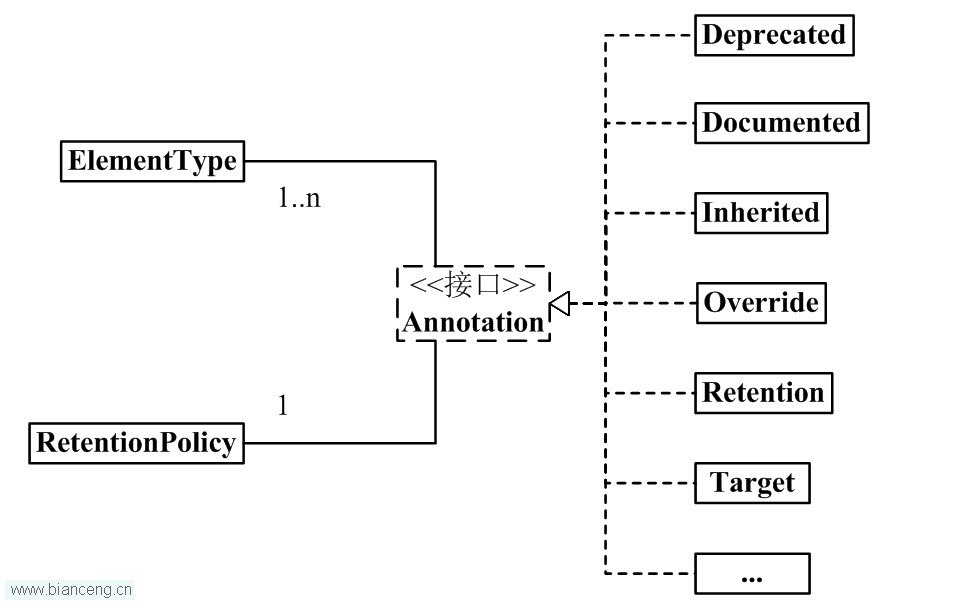
從中,我們可以看出:
(01) 1個Annotation 和 1個RetentionPolicy關聯。 可以理解為:每1個Annotation對象,都會有唯一的RetentionPolicy屬性。
(02) 1個Annotation 和 1~n個ElementType關聯。 可以理解為:對於每1個Annotation對象,可以有若干個ElementType屬性。
(03) Annotation 有許多實現類,包括:Deprecated, Documented, Inherited, Override等等。 Annotation 的每一個實現類,都“和1個RetentionPolicy關聯”並且“和1~n個ElementType關聯”。
下面,我先介紹框架圖的左半邊(如下圖),即Annotation, RetentionPolicy, ElementType;然後在就Annotation的實現類進行舉例說明。
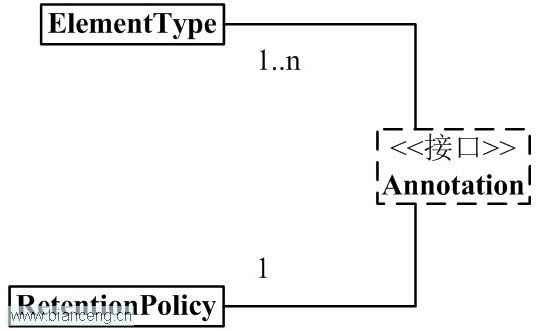
第2部分 Annotation組成部分
1 annotation組成成分
java annotation 的組成中,有3個非常重要的主干類。它們分別是:
(01) Annotation.java
package java.lang.annotation;
public interface Annotation {
boolean equals(Object obj);
int hashCode();
String toString();
Class<? extends Annotation> annotationType();
}
(02) ElementType.java
package java.lang.annotation;
public enum ElementType {
TYPE, /* 類、接口(包括注釋類型)或枚舉聲明 */
FIELD, /* 字段聲明(包括枚舉常量) */
METHOD, /* 方法聲明 */
PARAMETER, /* 參數聲明 */
CONSTRUCTOR, /* 構造方法聲明 */
LOCAL_VARIABLE, /* 局部變量聲明 */
ANNOTATION_TYPE, /* 注釋類型聲明 */
PACKAGE /* 包聲明 */
}
(03) RetentionPolicy.java
package java.lang.annotation;
public enum RetentionPolicy {
SOURCE, /* Annotation信息僅存在於編譯器處理期間,編譯器處理完之後就沒有該Annotation信息了 */
CLASS, /* 編譯器將Annotation存儲於類對應的.class文件中。默認行為 */
RUNTIME /* 編譯器將Annotation存儲於class文件中,並且可由JVM讀入 */
}
說明: (01) Annotation 就是個接口。 “每1個Annotation” 都與 “1個RetentionPolicy”關聯,並且與 “1~n個ElementType”關聯。可以通俗的理解為:每1個Annotation對象,都會有唯一的RetentionPolicy屬性;至於ElementType屬性,則有1~n個。
(02) ElementType 是Enum枚舉類型,它用來指定Annotation的類型。 “每1個Annotation” 都與 “1~n個ElementType”關聯。當Annotation與某個ElementType關聯時,就意味著:Annotation有了某種用途。 例如,若一個Annotation對象是METHOD類型,則該Annotation只能用來修飾方法。
(03) RetentionPolicy 是Enum枚舉類型,它用來指定Annotation的策略。通俗點說,就是不同RetentionPolicy類型的Annotation的作用域不同。 “每1個Annotation” 都與 “1個RetentionPolicy”關聯。 a) 若Annotation的類型為 SOURCE,則意味著:Annotation僅存在於編譯器處理期間,編譯器處理完之後,該Annotation就沒用了。 例如,“ @Override ”標志就是一個Annotation。當它修飾一個方法的時候,就意味著該方法覆蓋父類的方法;並且在編譯期間會進行語法檢查!編譯器處理完後,“@Override”就沒有任何作用了。 b) 若Annotation的類型為 CLASS,則意味著:編譯器將Annotation存儲於類對應的.class文件中,它是Annotation的默認行為。 c) 若Annotation的類型為 RUNTIME,則意味著:編譯器將Annotation存儲於class文件中,並且可由JVM讀入。
這時,只需要記住“每1個Annotation” 都與 “1個RetentionPolicy”關聯,並且與 “1~n個ElementType”關聯。學完後面的內容之後,再回頭看這些內容,會更容易理解。
第3部分 java自帶的Annotation
理解了上面的3個類的作用之後,我們接下來可以講解Annotation實現類的語法定義了。
@Documented @Target(ElementType.TYPE) @Retention(RetentionPolicy.RUNTIME) public @interface MyAnnotation1 { }
說明:
上面的作用是定義一個Annotation,它的名字是MyAnnotation1。定義了MyAnnotation1之後,我們可以在代碼中通過“@MyAnnotation1”來使用它。 其它的,@Documented, @Target, @Retention, @interface都是來修飾MyAnnotation1的。下面分別說說它們的含義:
(01) @interface 使用@interface定義注解時,意味著它實現了java.lang.annotation.Annotation接口,即該注解就是一個Annotation。 定義Annotation時,@interface是必須的。 注意:它和我們通常的implemented實現接口的方法不同。Annotation接口的實現細節都由編譯器完成。通過@interface定義注解後,該注解不能繼承其他的注解或接口。
(02) @Documented 類和方法的Annotation在缺省情況下是不出現在javadoc中的。如果使用@Documented修飾該Annotation,則表示它可以出現在javadoc中。 定義Annotation時,@Documented可有可無;若沒有定義,則Annotation不會出現在javadoc中。
(03) @Target(ElementType.TYPE) 前面我們說過,ElementType 是Annotation的類型屬性。而@Target的作用,就是來指定Annotation的類型屬性。 @Target(ElementType.TYPE) 的意思就是指定該Annotation的類型是ElementType.TYPE。這就意味著,MyAnnotation1是來修飾“類、接口(包括注釋類型)或枚舉聲明”的注解。 定義Annotation時,@Target可有可無。若有@Target,則該Annotation只能用於它所指定的地方;若沒有@Target,則該Annotation可以用於任何地方。
(04) @Retention(RetentionPolicy.RUNTIME) 前面我們說過,RetentionPolicy 是Annotation的策略屬性,而@Retention的作用,就是指定Annotation的策略屬性。 @Retention(RetentionPolicy.RUNTIME) 的意思就是指定該Annotation的策略是RetentionPolicy.RUNTIME。這就意味著,編譯器會將該Annotation信息保留在.class文件中,並且能被虛擬機讀取。 定義Annotation時,@Retention可有可無。若沒有@Retention,則默認是RetentionPolicy.CLASS。
2 java自帶的Annotation
通過上面的示例,我們能理解:@interface用來聲明Annotation,@Documented用來表示該Annotation是否會出現在javadoc中, @Target用來指定Annotation的類型,@Retention用來指定Annotation的策略。
理解這一點之後,我們就很容易理解java中自帶的Annotation的實現類,即Annotation架構圖的右半邊。如下圖:
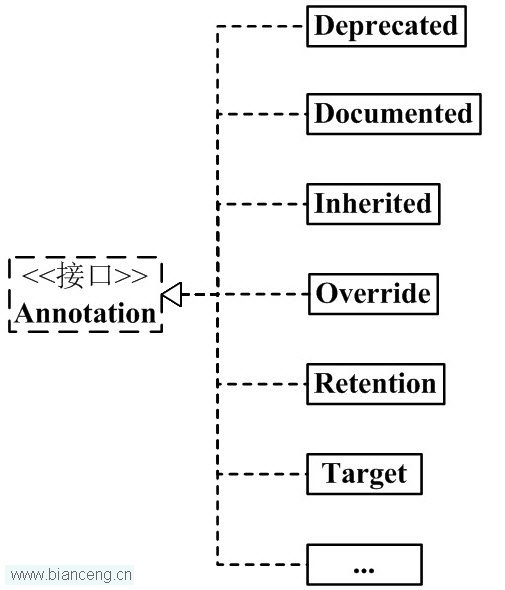
java 常用的Annotation:
@Deprecated -- @Deprecated 所標注內容,不再被建議使用。@Override -- @Override 只能標注方法,表示該方法覆蓋父類中的方法。@Documented -- @Documented 所標注內容,可以出現在javadoc中。@Inherited -- @Inherited只能被用來標注“Annotation類型”,它所標注的Annotation具有繼承性。@Retention -- @Retention只能被用來標注“Annotation類型”,而且它被用來指定Annotation的RetentionPolicy屬性。@Target -- @Target只能被用來標注“Annotation類型”,而且它被用來指定Annotation的ElementType屬性。@SuppressWarnings -- @SuppressWarnings 所標注內容產生的警告,編譯器會對這些警告保持靜默。
由於“@Deprecated和@Override”類似,“@Documented, @Inherited, @Retention, @Target”類似;下面,我們只對@Deprecated, @Inherited, @SuppressWarnings 這3個Annotation進行說明。
2.1 @Deprecated
@Deprecated 的定義如下:
@Documented @Retention(RetentionPolicy.RUNTIME) public @interface Deprecated { }
說明: (01) @interface -- 它的用來修飾Deprecated,意味著Deprecated實現了java.lang.annotation.Annotation接口;即Deprecated就是一個注解。 (02) @Documented -- 它的作用是說明該注解能出現在javadoc中。 (03) @Retention(RetentionPolicy.RUNTIME) -- 它的作用是指定Deprecated的策略是RetentionPolicy.RUNTIME。這就意味著,編譯器會將Deprecated的信息保留在.class文件中,並且能被虛擬機讀取。 (04) @Deprecated 所標注內容,不再被建議使用。 例如,若某個方法被 @Deprecated 標注,則該方法不再被建議使用。如果有開發人員試圖使用或重寫被@Deprecated標示的方法,編譯器會給相應的提示信息。示例如下:
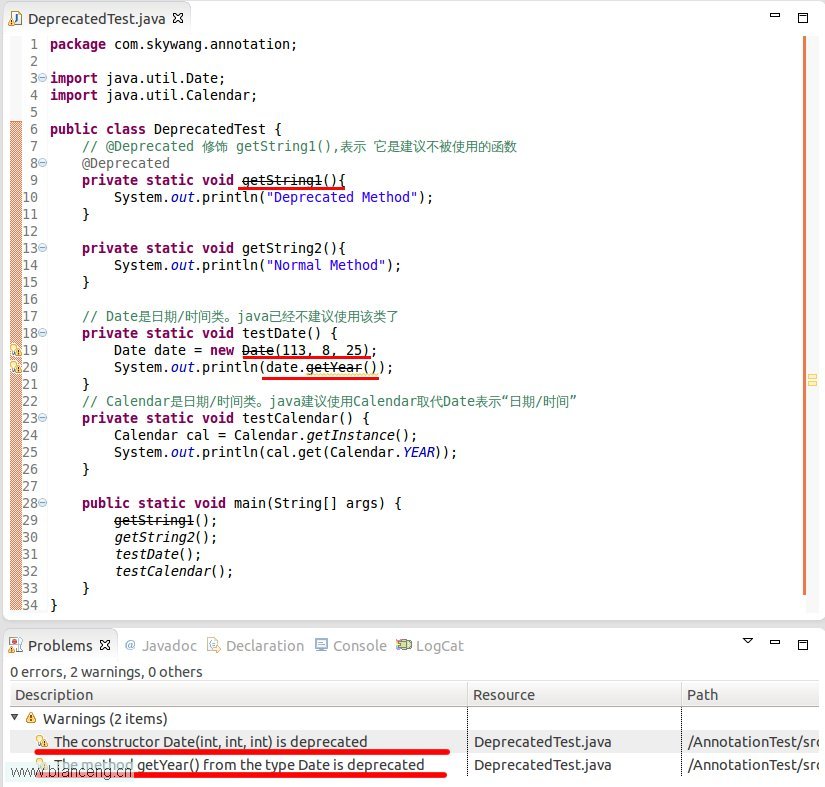
源碼如下(DeprecatedTest.java):
package com.skywang.annotation;
import java.util.Date;
import java.util.Calendar;
public class DeprecatedTest {
// @Deprecated 修飾 getString1(),表示 它是建議不被使用的函數
@Deprecated
private static void getString1(){
System.out.println("Deprecated Method");
}
private static void getString2(){
System.out.println("Normal Method");
}
// Date是日期/時間類。java已經不建議使用該類了
private static void testDate() {
Date date = new Date(113, 8, 25);
System.out.println(date.getYear());
}
// Calendar是日期/時間類。java建議使用Calendar取代Date表示“日期/時間”
private static void testCalendar() {
Calendar cal = Calendar.getInstance();
System.out.println(cal.get(Calendar.YEAR));
}
public static void main(String[] args) {
getString1();
getString2();
testDate();
testCalendar();
}
}
說明: 上面是eclipse中的截圖,比較類中 “getString1() 和 getString2()” 以及 “testDate() 和 testCalendar()” 。
(01) getString1() 被@Deprecated標注,意味著建議不再使用getString1();所以getString1()的定義和調用時,都會一橫線。這一橫線是eclipse()對@Deprecated方法的處理。 getString2() 沒有被@Deprecated標注,它的顯示正常。
(02) testDate() 調用了Date的相關方法,而java已經建議不再使用Date操作日期/時間。因此,在調用Date的API時,會產生警告信息,途中的warnings。 testCalendar() 調用了Calendar的API來操作日期/時間,java建議用Calendar取代Date。因此,操作Calendar不回產生warning。
2.2 @Inherited
@Inherited 的定義如下:
@Documented @Retention(RetentionPolicy.RUNTIME) @Target(ElementType.ANNOTATION_TYPE) public @interface Inherited { }
說明: (01) @interface -- 它的用來修飾Inherited,意味著Inherited實現了java.lang.annotation.Annotation接口;即Inherited就是一個注解。 (02) @Documented -- 它的作用是說明該注解能出現在javadoc中。 (03) @Retention(RetentionPolicy.RUNTIME) -- 它的作用是指定Inherited的策略是RetentionPolicy.RUNTIME。這就意味著,編譯器會將Inherited的信息保留在.class文件中,並且能被虛擬機讀取。 (04) @Target(ElementType.ANNOTATION_TYPE) -- 它的作用是指定Inherited的類型是ANNOTATION_TYPE。這就意味著,@Inherited只能被用來標注“Annotation類型”。 (05) @Inherited 的含義是,它所標注的Annotation將具有繼承性。 假設,我們定義了某個Annotaion,它的名稱是MyAnnotation,並且MyAnnotation被標注為@Inherited。現在,某個類Base使用了MyAnnotation,則Base具有了“具有了注解MyAnnotation”;現在,Sub繼承了Base,由於MyAnnotation是@Inherited的(具有繼承性),所以,Sub也“具有了注解MyAnnotation”。
@Inherited的使用示例 源碼如下(InheritableSon.java):
/** * @Inherited 演示示例 * * @author skywang * @email [email protected] */ package com.skywang.annotation; import java.lang.annotation.Target; import java.lang.annotation.ElementType; import java.lang.annotation.Retention; import java.lang.annotation.RetentionPolicy; import java.lang.annotation.Inherited; /** * 自定義的Annotation。 */ @Target(ElementType.TYPE) @Retention(RetentionPolicy.RUNTIME) @Inherited @interface Inheritable { } @Inheritable class InheritableFather { public InheritableFather() { // InheritableBase是否具有 Inheritable Annotation System.out.println("InheritableFather:"+InheritableFather.class.isAnnotationPresent(Inheritable.class)); } } /** * InheritableSon 類只是繼承於 InheritableFather, */ public class InheritableSon extends InheritableFather { public InheritableSon() { super(); // 調用父類的構造函數 // InheritableSon類是否具有 Inheritable Annotation System.out.println("InheritableSon:"+InheritableSon.class.isAnnotationPresent(Inheritable.class)); } public static void main(String[] args) { InheritableSon is = new InheritableSon(); } }
運行結果:
InheritableFather:true InheritableSon:true
現在,我們對InheritableSon.java進行修改:注釋掉“Inheritable的@Inherited注解”。 源碼如下(InheritableSon.java):
/** * @Inherited 演示示例 * * @author skywang * @email [email protected] */ package com.skywang.annotation; import java.lang.annotation.Target; import java.lang.annotation.ElementType; import java.lang.annotation.Retention; import java.lang.annotation.RetentionPolicy; import java.lang.annotation.Inherited; /** * 自定義的Annotation。 */ @Target(ElementType.TYPE) @Retention(RetentionPolicy.RUNTIME) //@Inherited @interface Inheritable { } @Inheritable class InheritableFather { public InheritableFather() { // InheritableBase是否具有 Inheritable Annotation System.out.println("InheritableFather:"+InheritableFather.class.isAnnotationPresent(Inheritable.class)); } } /** * InheritableSon 類只是繼承於 InheritableFather, */ public class InheritableSon extends InheritableFather { public InheritableSon() { super(); // 調用父類的構造函數 // InheritableSon類是否具有 Inheritable Annotation System.out.println("InheritableSon:"+InheritableSon.class.isAnnotationPresent(Inheritable.class)); } public static void main(String[] args) { InheritableSon is = new InheritableSon(); } }
運行結果:
InheritableFather:true InheritableSon:false
對比上面的兩個結果,我們發現:當注解Inheritable被@Inherited標注時,它具有繼承性。否則,沒有繼承性。
2.3 @SuppressWarnings
@SuppressWarnings 的定義如下:
@Target({TYPE, FIELD, METHOD, PARAMETER, CONSTRUCTOR, LOCAL_VARIABLE})
@Retention(RetentionPolicy.SOURCE)
public @interface SuppressWarnings {
String[] value();
}
說明: (01) @interface -- 它的用來修飾SuppressWarnings,意味著SuppressWarnings實現了java.lang.annotation.Annotation接口;即SuppressWarnings就是一個注解。 (02) @Retention(RetentionPolicy.SOURCE) -- 它的作用是指定SuppressWarnings的策略是RetentionPolicy.SOURCE。這就意味著,SuppressWarnings信息僅存在於編譯器處理期間,編譯器處理完之後SuppressWarnings就沒有作用了。 (03) @Target({TYPE, FIELD, METHOD, PARAMETER, CONSTRUCTOR, LOCAL_VARIABLE}) -- 它的作用是指定SuppressWarnings的類型同時包括TYPE, FIELD, METHOD, PARAMETER, CONSTRUCTOR, LOCAL_VARIABLE。 TYPE意味著,它能標注“類、接口(包括注釋類型)或枚舉聲明”。 FIELD意味著,它能標注“字段聲明”。 METHOD意味著,它能標注“方法”。 PARAMETER意味著,它能標注“參數”。 CONSTRUCTOR意味著,它能標注“構造方法”。 LOCAL_VARIABLE意味著,它能標注“局部變量”。 (04) String[] value(); 意味著,SuppressWarnings能指定參數 (05) SuppressWarnings 的作用是,讓編譯器對“它所標注的內容”的某些警告保持靜默。例如,"@SuppressWarnings(value={"deprecation", "unchecked"})" 表示對“它所標注的內容”中的 “SuppressWarnings不再建議使用警告”和“未檢查的轉換時的警告”保持沉默。示例如下:
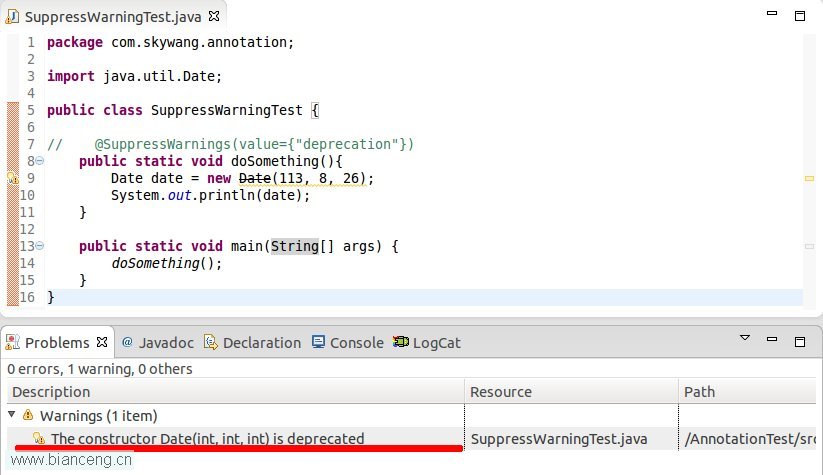
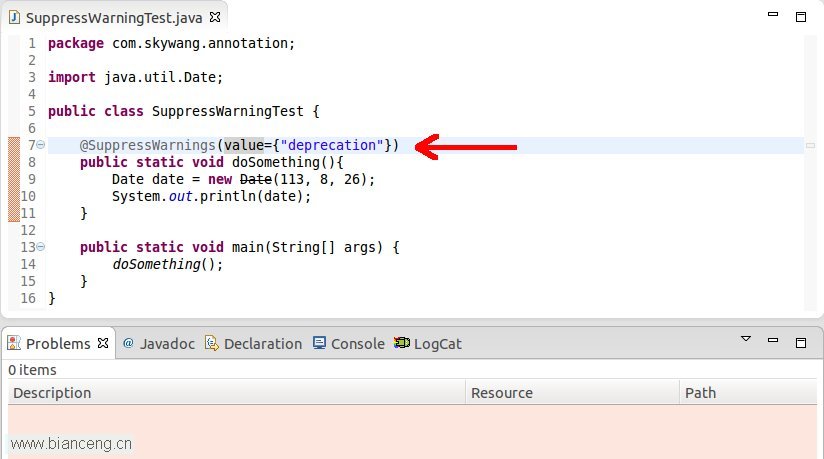
源碼如下(SuppressWarningTest.java):
package com.skywang.annotation;
import java.util.Date;
public class SuppressWarningTest {
//@SuppressWarnings(value={"deprecation"})
public static void doSomething(){
Date date = new Date(113, 8, 26);
System.out.println(date);
}
public static void main(String[] args) {
doSomething();
}
}
說明: (01) 左邊的圖中,沒有使用 @SuppressWarnings(value={"deprecation"}) , 而Date屬於java不再建議使用的類。因此,調用Date的API時,會產生警告。 而右邊的途中,使用了 @SuppressWarnings(value={"deprecation"})。因此,編譯器對“調用Date的API產生的警告”保持沉默。
補充:SuppressWarnings 常用的關鍵字的表格
deprecation -- 使用了不贊成使用的類或方法時的警告 unchecked -- 執行了未檢查的轉換時的警告,例如當使用集合時沒有用泛型 (Generics) 來指定集合保存的類型。 fallthrough -- 當 Switch 程序塊直接通往下一種情況而沒有 Break 時的警告。 path -- 在類路徑、源文件路徑等中有不存在的路徑時的警告。 serial -- 當在可序列化的類上缺少 serialVersionUID 定義時的警告。 finally -- 任何 finally 子句不能正常完成時的警告。 all -- 關於以上所有情況的警告。
第4部分 Annotation 的作用
Annotation 是一個輔助類,它在Junit、Struts、Spring等工具框架中被廣泛使用。
我們在編程中經常會使用到的Annotation作用有:
1 編譯檢查
Annotation具有“讓編譯器進行編譯檢查的作用”。
例如,@SuppressWarnings, @Deprecated和@Override都具有編譯檢查作用。 (01) 關於@SuppressWarnings和@Deprecated,已經在“第3部分”中詳細介紹過了。這裡就不再舉例說明了。 (02) 若某個方法被 @Override的 標注,則意味著該方法會覆蓋父類中的同名方法。如果有方法被@Override標示,但父類中卻沒有“被@Override標注”的同名方法,則編譯器會報錯。示例如下:
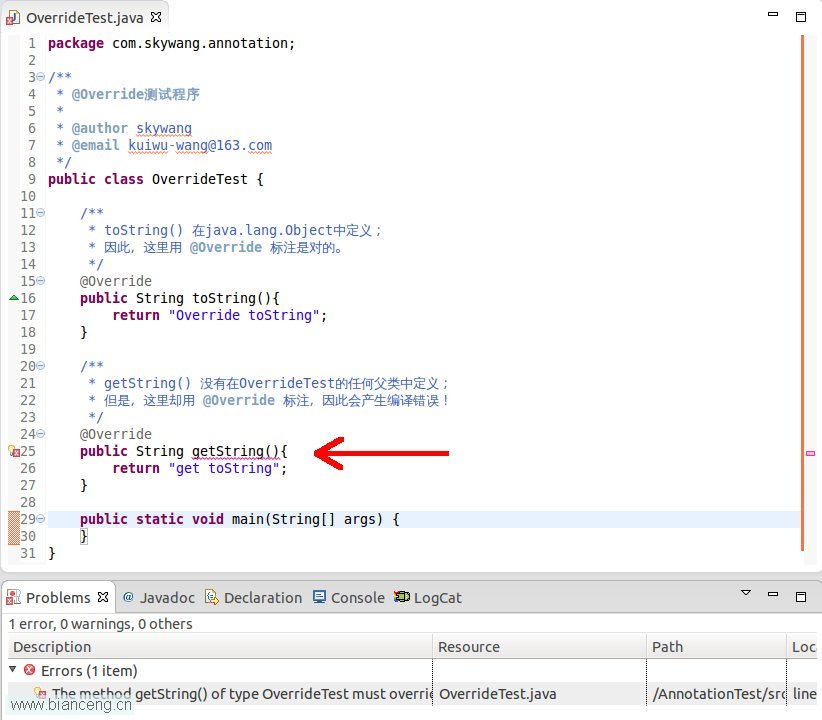
查看本欄目
源碼(OverrideTest.java):
package com.skywang.annotation;
/**
* @Override測試程序
*
* @author skywang
* @email [email protected]
*/
public class OverrideTest {
/**
* toString() 在java.lang.Object中定義;
* 因此,這裡用 @Override 標注是對的。
*/
@Override
public String toString(){
return "Override toString";
}
/**
* getString() 沒有在OverrideTest的任何父類中定義;
* 但是,這裡卻用 @Override 標注,因此會產生編譯錯誤!
*/
@Override
public String getString(){
return "get toString";
}
public static void main(String[] args) {
}
}
上面是該程序在eclipse中的截圖。從中,我們可以發現“getString()”函數會報錯。這是因為“getString() 被@Override所標注,但在OverrideTest的任何父類中都沒有定義getString1()函數”。 “將getString() 上面的@Override注釋掉”,即可解決該錯誤。
2 在反射中使用Annotation
在反射的Class, Method, Field等函數中,有許多於Annotation相關的接口。 這也意味著,我們可以在反射中解析並使用Annotation。 源碼如下(AnnotationTest.java):
package com.skywang.annotation;
import java.lang.annotation.Annotation;
import java.lang.annotation.Target;
import java.lang.annotation.ElementType;
import java.lang.annotation.Retention;
import java.lang.annotation.RetentionPolicy;
import java.lang.annotation.Inherited;
import java.lang.reflect.Method;
/**
* Annotation在反射函數中的使用示例
*
* @author skywang
* @email [email protected]
*/
@Retention(RetentionPolicy.RUNTIME)
@interface MyAnnotation {
String[] value() default "unknown";
}
/**
* Person類。它會使用MyAnnotation注解。
*/
class Person {
/**
* empty()方法同時被 "@Deprecated" 和 “@MyAnnotation(value={"a","b"})”所標注
* (01) @Deprecated,意味著empty()方法,不再被建議使用
* (02) @MyAnnotation, 意味著empty() 方法對應的MyAnnotation的value值是默認值"unknown"
*/
@MyAnnotation
@Deprecated
public void empty(){
System.out.println("\nempty");
}
/**
* sombody() 被 @MyAnnotation(value={"girl","boy"}) 所標注,
* @MyAnnotation(value={"girl","boy"}), 意味著MyAnnotation的value值是{"girl","boy"}
*/
@MyAnnotation(value={"girl","boy"})
public void somebody(String name, int age){
System.out.println("\nsomebody: "+name+", "+age);
}
}
public class AnnotationTest {
public static void main(String[] args) throws Exception {
// 新建Person
Person person = new Person();
// 獲取Person的Class實例
Class<Person> c = Person.class;
// 獲取 somebody() 方法的Method實例
Method mSomebody = c.getMethod("somebody", new Class[]{String.class, int.class});
// 執行該方法
mSomebody.invoke(person, new Object[]{"lily", 18});
iteratorAnnotations(mSomebody);
// 獲取 somebody() 方法的Method實例
Method mEmpty = c.getMethod("empty", new Class[]{});
// 執行該方法
mEmpty.invoke(person, new Object[]{});
iteratorAnnotations(mEmpty);
}
public static void iteratorAnnotations(Method method) {
// 判斷 somebody() 方法是否包含MyAnnotation注解
if(method.isAnnotationPresent(MyAnnotation.class)){
// 獲取該方法的MyAnnotation注解實例
MyAnnotation myAnnotation = method.getAnnotation(MyAnnotation.class);
// 獲取 myAnnotation的值,並打印出來
String[] values = myAnnotation.value();
for (String str:values)
System.out.printf(str+", ");
System.out.println();
}
// 獲取方法上的所有注解,並打印出來
Annotation[] annotations = method.getAnnotations();
for(Annotation annotation : annotations){
System.out.println(annotation);
}
}
}
運行結果: somebody: lily, 18 girl, boy, @com.skywang.annotation.MyAnnotation(value=[girl, boy])
empty unknown, @com.skywang.annotation.MyAnnotation(value=[unknown]) @java.lang.Deprecated()
3 根據Annotation生成幫助文檔
通過給Annotation注解加上@Documented標簽,能使該Annotation標簽出現在javadoc中。
4 能夠幫忙查看查看代碼
通過@Override, @Deprecated等,我們能很方便的了解程序的大致結構。 另外,我們也可以通過自定義Annotation來實現一些功能。